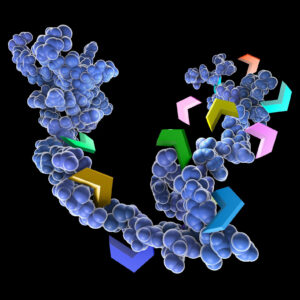Biotinylation is an attractive approach for protein complex purification due to the very high affinity (Kd = 10–15 M) of avidin/streptavidin for biotinylated templates. With typical avidin or streptavidin, the biotin-binding affinity is so great that purification with these traditional media require denaturing conditions for elution,such as 8 M Guanidine•HCl at pH 1.5 or boiling in reducing SDS-PAGE sample loading buffer. To avoid these harsh conditions SoftLink™ Soft Release Avidin resin can be used. These particles consist of monomeric avidin coupled to a methylacrylate resin.
This resin provides the same specificity of binding to biotin afforded by tetrameric biotin, but enables the release of biotinlylated molecules under mild nondenaturing conditions (5mM biotin).
The following are recent references that used the SoftLink™ Resin for the noted application:
Kashwayama, Y. et al. (2010) Identification of a substrate-binding site in a peroxisomal beta-oxidation enzyme by photoaffinity labeling with a novel palmitoyl derivative. J. Biol. Chem. 285, 26315–25. (Purification of photoaffinity labeled proteins for subquenant binding/activity experiments)
Takahashi, M. et al. (2010) Tailor-made RNAi knockdown against triplet repeat disease-causing alleles. Proc. Natl. Acad. Sci. 107, 21731-36 (Innovated procedure using biotin labeled cDNAs for the identification of nucleotide variations)
Kress, D. et al. (2009) An asymmetric model for Na+-translocating glutaconyl-CoA decarboxylases. J. Biol.Chem. 284, 28401–9 (Purification of Clostridium biotin carrier proteins that play a role in decarboxylation)
Akahori, Y. et al. (2009) Characterization of neutralizing epitopes of varicella-zoster virus glycoprotein H. J. Virol. 83, 2020–4. (purification of double stranded cDNA fragments amplified by PCR with a biotin-tagged PCR primer)
Shonsey, E.M. et al. (2008) Inactivation of human liver bile acid CoA:amino acid N-acyltransferase by the electrophilic lipid, 4-hydroxynonenal. J. Lipid Res. 49, 282–94 (purification of recombinant protein expressed in E.coli containing C-terminal avidin tag)
Andachi, Y. et al. (2008) A novel biochemical method to identify target genes of individual microRNAs: identification of a new Caenorhabditis elegans let-7 target. RNA 14, 2440–51 (purification of double stranded cDNA fragments amplified by PCR with a biotin-tagged PCR primer)
For more information about SoftLink™ Soft Release Avidin Resin, please visit our website.





